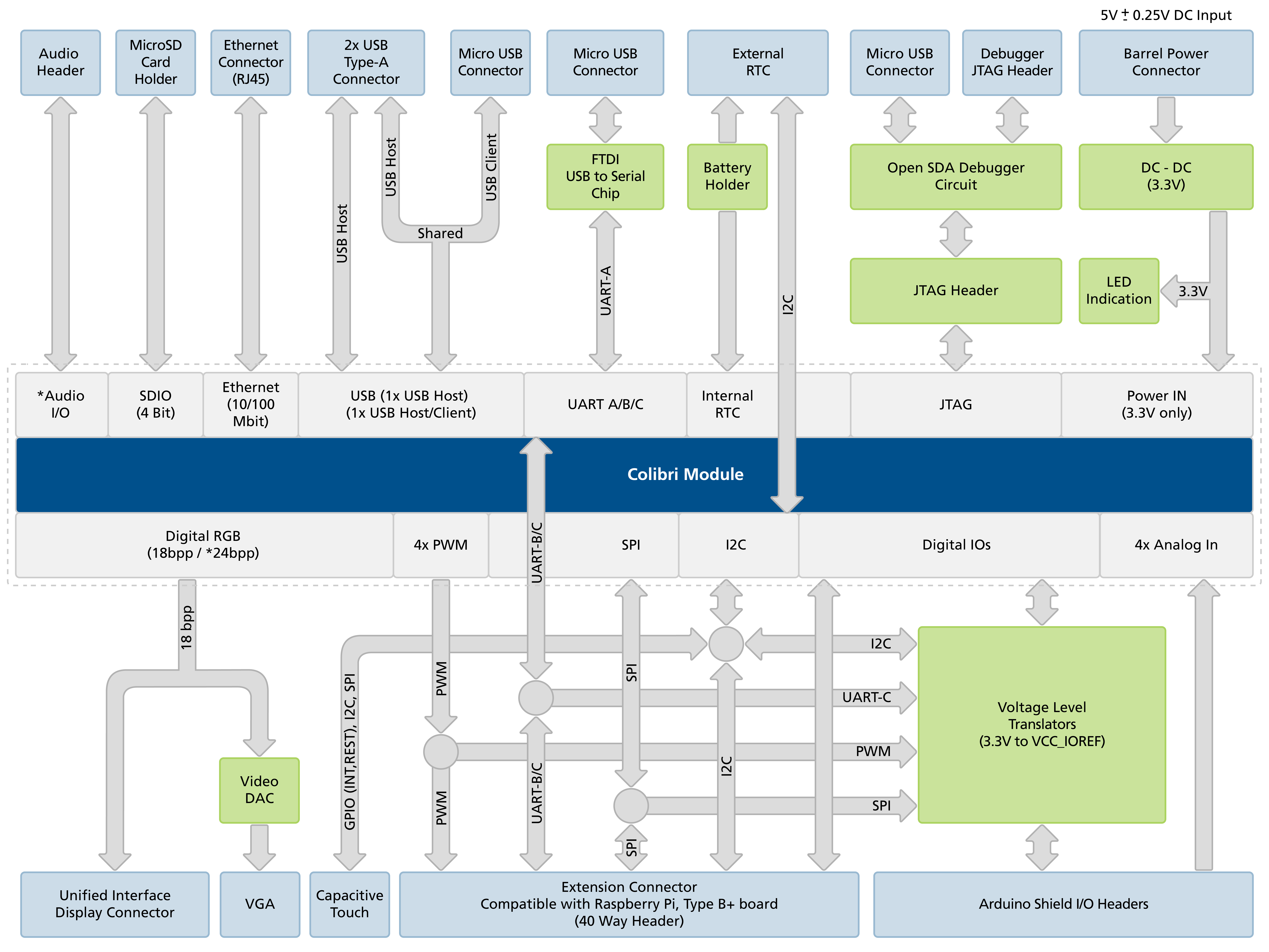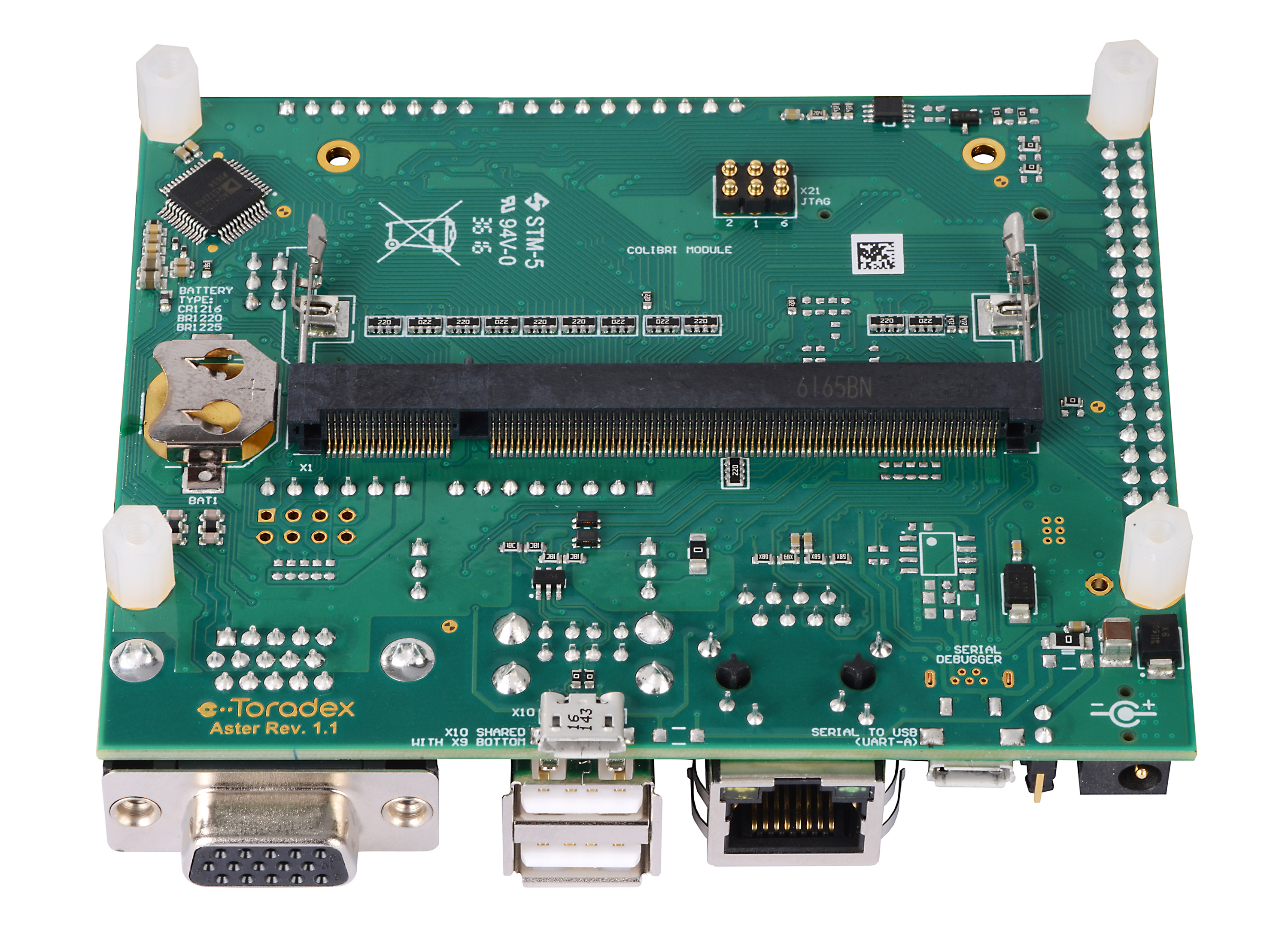Aster Carrier Board
Getting Started
Aster is a carrier board for the Colibri family of computer-on-modules. Aster carrier board has been designed primarily considering Colibri VFxx computer-on-modules, but the carrier board is compatible with all the products in the Colibri family.
Aster has been designed for students, makers and hobbyists. The Aster Carrier Board has headers compatible with Arduino Uno and Raspberry Pi (RPi) maker boards, thus enabling users to use a variety of 3rd party modules/add-on boards like Arduino Shields and Raspberry Pi adapter boards.
Recommendation for a first-time order
Toradex recommends to order the following additional products for your fist-time order:
- Any Colibri module
- The Carrier Board Accessory Kit (please note that the power supply of the kit is not compatible with Aster)
All the products can be ordered online at Toradex Webshop.
Getting started for the first time?
For detailed step-by-step instructions about how to start with both, SoM and Carrier Board, please have a look at our step-by-step Getting-Started Guide:
Since Aster can be USB powered, the simplest setup possible requires only:
- Cables: USB Micro-AB to Type-A (receptacle)
- Jumper Wire to short-circuit JP1
Powering through USB will limit the total amount of power available. We recommend using an external power supply when using a lot of power for e.g. display or other peripherals, since this setup isn't USB compliant.
Do not short-circuit the jumper JP1 if you are using an external power supply: it will cause the external supply and the USB supply to be shorted.
Having trouble?
Please contact our technical support. Various option of technical support are mentioned in the article below.
Features
I/O Support
- Ethernet (1x 10/100 Mbit)
- USB 2.0 (1x Host, 1x Host/Client)
- SDIO/SD/MMC (1x 4 Bit)
- CAN (up-to 2x, TX/RX)
- VGA (1x, Shared with RGB)
- RGB (1x)
- Resistive Touch (1x)
- Capacitive Touch (1x)
- USB-to-Serial Transceiver (1x)
- UART (2x TTL, 1x USB)
- I2C (1x)
- SPI (1x)
- PWM (4x)
- GPIO (up-to 39)
- Analog Input (4x)
- Analog Audio: Line in (1x)
- Analog Audio: Mic in (1x)
- Analog Audio: Headphone out (1x)
Block Diagram

* Please note that these features are module-specific and may not be supported by all the computer-on-modules in the Colibri family. For more details, refer to the datasheet of Colibri computer-on-modules.
Datasheets
Aster Carrier Board V1.1
Aster Carrier Board V1.1 Datasheet
Components
- USB Power Controller
- Synchronous DC-DC Buck Converter
- USB to Serial UART Converter
- Voltage Level Translator
- I2C / SM Bus Voltage Level Translator
- Video DAC
Design Resources
Design data Aster Carrier Board V1.1
- Aster Carrier Board Altium Project (Altium Designer Release 10)
- Aster Carrier Board PDF Schematics
- Aster Carrier Board Assembly Drawing
- Aster Carrier Board Bill of Materials (BOM)
Aster Carrier Board Mechanical Models
A basic 3D model for the Aster Carrier Board can be downloaded here:
- SolidWorks CAD model 3D EASM model
- You can download the free eDrawings model viewer from SolidWorks here
- 3D STEP model that can be opened and modified in any 3D CAD
- 3D PDF model that can be opened in Adobe Reader
Design and Layout Guide
Altium Designer
Compatible Products
- Colibri iMX8X
- Colibri iMX7
- Colibri iMX6
- Colibri iMX6ULL
- Colibri VF61
- Colibri VF50
- Colibri T30
- Colibri T20
- Colibri PXA320
- Colibri PXA310
- Colibri PXA270
- EDT Display
- Carrier Board Accessory Kit
- Capacitive Touch Display 7" Parallel
- Resistive Touch Display 7" Parallel
- LM816 USB WiFi
- Analogue Camera Adapter
Revision History
Click to See the Product Numbering Scheme
Product Number (PID8) Format
The format of the 8-digits Product Number (PID8) is the following:

The below table describes the structure of the Product Number (PID8):
| Field | Description |
|---|---|
| PPPP | 4-digits number, indicating the Product Configuration (PID4) that describes the key properties of the product (e.g. Product Group, RAM capacity, etc.) |
| VV | 2-digits number, indicating the Major and Minor Version (in that order) |
| AA | 2-digits number, indicating the Assembly Variant |
See the complete list of available combinations on the Revision History table of the corresponding product page.
Example
Product number (PID8): 00291100:
0029: Apalis iMX6D 512MB
11: Major Version 1, Minor Version 1, Version V1.1 in short
00: Assembly Variant A
A specific product revision has a lifecycle defined by the product state. Learn more about it on the Product Change Notifications.
Aster Carrier Board
PN: 0143
| Product # | Product Description | Changes from Previous Version | Release Date | PCN Document |
01431000 | Aster V1.0A | Initial Release | Q2 2016 | Obsolete |
01431100 | Aster V1.1A | Fixed VGA polarity issue with Vybrid Fixed shared USB host/client issue when other USB devices are connected | Q1 2017 | |
01431101 | Aster V1.1B | Added JTAG through pogo pins and X6 | Feb 2017 |
Errata
None

